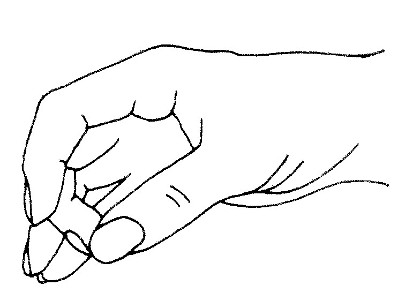You can see that I'm holding on here for dear life, after Robin helped me up. I wasn't strong enough to get there on my own. One of the goals in this pose is to be in Tadasana (albeit upside down), with my feet level and my legs straight and strong. I started out that way, but at this point, I'm using the wall for support, doing an unintentional back bend. These are a few things I see; a yoga instructor would have much more to suggest about correct positioning. Notice that I'm critiquing my pose, not criticizing it. There's a big difference.
In some ways, the sloppiness of my pose doesn't matter. I got up there, which is more than most people I know could or would do. I managed to work through the rush of panic without freaking out and I stayed in the pose for a few minutes. I had some idea of how the pose should feel and look and I did manage to take my feet away from the wall in an attempt at Tadasana. If I never do this again, I still have a few bragging rights.
(Incidentally, Robin was correct-when I went up, I had a very sore right shoulder, enough to wake me up at night. "This will help," she assured me, although I couldn't see how balancing on a painful area would relieve the discomfort. It's been two nights now, and I haven't been disturbed by shoulder pain one bit. Go figure.)
It's not enough. Now that I know I can do shoulder stand, I want to improve my pose. I've looked closely at the photo, asked questions about adjustments, annoyed yoga teachers about why this and that. I'm looking to move out of my comfort zone because that's how I learn and grow.
Comfort zones are there for good reasons. Sometimes, it's nice to play safe, to look for the soothing tones of the familiar. Staying in the warm, fuzzy areas can keep us happy, away from risk. Those aren't problems, unless and until we use comfort to numb our experiences and allow ourselves to shrink from challenges. If you refuse all challenges, you'll end up as a warm puddle on your couch, afraid to interact with the world. You literally won't know your own body or mind.
Many fibre people take up knitting or spinning or other fibre crafts for those comfort experiences. We seek to escape the pressures of our jobs, our families, the stresses of life, our selves. Spinning plain yarns, knitting garter stitch scarves by the truckload help us feel good. Not only do our crafts calm us, we make something useful in the process. Again, there is no judgment here. I'm a big, big fan of garter stitch and plain 2 ply yarn. We are forced to deal with stress every day; we don't have to add more if we'd rather not.
The thing is, if we're able to do something at all, why not explore our limits? Once in a while, we need to step outside those boundaries, face our fears head on (or down, as the case may be) and go for it. If you always knit garter stitch scarves, consider working a simple shawl, perhaps with an easy lace border. Continue spinning those plain yarns, but throw some deliberate designer lumps and bumps into one or two skeins.
 |
| This little shawl is nothing but garter stitch and yarn overs. |
Rather than adding to our stresses, challenges will actually alleviate the pressures we face. When you are working on something new, you have to pay attention, which means you don't have the time or space to worry about the daily annoyances which build stress. You pick your challenge, research it and do it safely, to the best of your abilities. Then you push a little more. (Safety is much more important with a physical challenge. Although I've seen some impressive spinning and knitting failures, apart from a rush of forceful language and some tears, fibre flaws are rarely fatal.)
It's that "pushing a little more" that will take you places and enrich your world. So, go on, take a baby step or two. You may soon find yourself running.
As for me, I've been behaving like a little kid all week, begging people to help "Me go upside down!" It feels good.
Namaste.
 |
| A bit of hand spun yarn, garter stitch, some holes and a sense of adventure can take you places. It really is okay to colour outside the lines! |
















